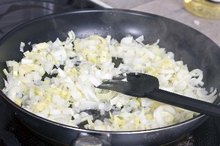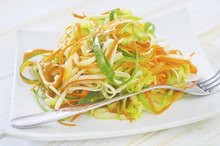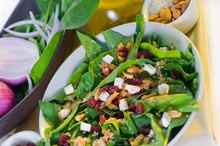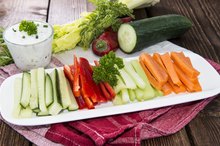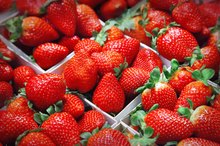What does fact checked mean?
At Healthfully, we strive to deliver objective content that is accurate and up-to-date. Our team periodically reviews articles in order to ensure content quality. The sources cited below consist of evidence from peer-reviewed journals, prominent medical organizations, academic associations, and government data.
The information contained on this site is for informational purposes only, and should not be used as a substitute for the advice of a professional health care provider. Please check with the appropriate physician regarding health questions and concerns. Although we strive to deliver accurate and up-to-date information, no guarantee to that effect is made.
Nutritional Facts of Pineapples and Mangoes
Tropical fruits such as mango and pineapple can add unique flavor and a variety of nutrients to your diet 4. These fruits both make nutritious, low-calorie snacks. You can also add them to salads, mix them with yogurt, add them to baked goods or stir them into cooked chicken and fish dishes.
Tips
Pineapples Mangoes has 350 Calories and 90.00 g of Carbohydrate, by difference per 100 gram serving according to the nutrition facts provided by the USDA Food Composition Database.
Calories
Pineapple and mango both derive their calories primarily from carbohydrates 4. Mango, however, is higher in calories per cup. One cup of mango contains 107 calories, while a cup of pineapple contains 74 calories 4. Mango is also slightly higher in fiber. One cup contains 3 g, which supplies 12 percent of the daily value. One cup of pineapple contains 2.2 g and provides 9 percent 4. Both fruits contain less than 1 g of both protein and fat.
Fat-soluble Vitamins
Nutritional Content of Melons
Learn More
Although mangoes provide very little fat, they do supply a variety of fat-soluble vitamins. One cup of raw mango supplies 25 percent of the daily value of vitamin A, which helps with night vision. Vitamin A also helps maintain the skin and mucosal cells, which are the first cells to fight infection. For this reason, vitamin A is important for proper immune system function. One cup of mango also supplies 6 percent of vitamin E and 9 percent of vitamin K. Pineapple contains smaller amounts of these fat-soluble vitamins 4. One cup provides 2 percent of vitamin A, 1 percent of vitamin K and less than 1 percent of vitamin E.
- Although mangoes provide very little fat, they do supply a variety of fat-soluble vitamins.
- One cup of raw mango supplies 25 percent of the daily value of vitamin A, which helps with night vision.
Water-soluble Vitamins
Pineapple may be lower in fat-soluble vitamins, but it contains more vitamin C than mango 4. One cup of pineapple provides 94 percent of this water-soluble vitamin 4. One cup of mango supplies 76 percent. Your body does not make or store vitamin C, so you must replenish this vitamin on a daily basis. Pineapple and mango also contain smaller amounts of the water-soluble B vitamins 4. One cup of mango supplies 6 percent of thiamine, 6 percent of riboflavin, 5 percent of niacin, 11 percent of B-6 and 6 percent of folate. One cup of pineapple provides 8 percent of thiamine, 3 percent of riboflavin, 4 percent of niacin, 9 percent of B-6 and 6 percent of folate 4.
Minerals
Vitamins & Minerals in Pineapple
Learn More
Pineapple contains only small amounts of most minerals, except manganese 4. One cup of pineapple supplies 91 percent of this mineral, which helps you make sex hormones and build strong bones 4. It also assists in the metabolism of carbohydrates and fat. Additionally, 1 cup of pineapple provides 8 percent of copper and 5 percent of potassium 4. Unlike pineapple, mango supplies only a trace amount of manganese 4. However, 1 cup provides 7 percent of potassium and 9 percent of copper.
Related Articles
References
- Linus Pauling Institute: Vitamin A
- MedlinePlus: Vitamin C
- Pineapple, raw. FoodData Central. U.S. Department of Agriculture. Published April 1, 2019.
- The glycemic index. Diabetes Canada. 2020.
- Copper. National Institutes of Health Office of Dietary Supplements. 2019.
- Bromelain. National Institutes of Health. National Center for Complementary and Integrated Health. Updated 2016.
- Muhammad ZA, Ahmad T. Therapeutic uses of pineapple-extracted bromelain in surgical care - A review. J Pak Med Assoc. 2017;67(1):121-125.
- van Eekelen E, Geelen A, Alssema M, et al. Sweet snacks are positively and fruits and vegetables are negatively associated with visceral or liver fat content in middle-aged men and women. J Nutr. 2019;149(2):304-313. doi:10.1093/jn/nxy260
- Vitamin C Fact Sheet for Health Professionals. National Institutes of Health. Office of Dietary Supplements. Updated 2019.
- Anderson JJ, Nieman DC. Diet quality-the Greeks had it right!. Nutrients. 2016;8(10). doi:10.3390/nu8100636
- Chang TC, Wei PL, Makondi PT, Chen WT, Huang CY, Chang YJ. Bromelain inhibits the ability of colorectal cancer cells to proliferate via activation of ROS production and autophagy. PLoS ONE. 2019;14(1):e0210274. doi:10.1371/journal.pone.0210274
- Ask the Expert: Anaphylactic Reactions to Cherries, Strawberries, and Grapes. American Academy of Allergy Asthma and Immunology. Milwaukee, Wisc. 2020.
- Possible interactions with: bromelain. Penn State Hershey Milton S. Hershey Medical Center. 2011.
- Pineapples. SNAP-Ed connection U.S. Department of Agriculture.
- Selecting and serving produce safely. U.S. Food and Drug Administration.
Writer Bio
Lisa Thompson has been writing since 2008, when she began writing for the Prevention website. She is a holistic health practitioner, nationally certified massage therapist and National Council on Strength and Fitness-certified personal trainer. Thompson also holds certificates in nutrition and herbology from the Natural Healing Institute, as well as a Master of Education from California State University.


